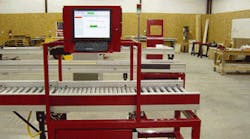The "fulfillment house" of yesterday has evolved into a strategic business partner that provides a wide range of products and services on behalf of clients who need to deliver information and merchandise to its customers with breathtaking speed. Incorporating a multitude of processing and communications technologies, companies such as FillTek (Cincinnati, Ohio) handle fulfillment services for a range of businesses that generate orders or inquiries via print, broadcast, Internet or direct marketing.
"The key to succeeding at a high level in this business is learning our individual customer's needs, and then developing processes internally that fit those needs, rather than simply tying to adapt customers to your capabilities," explains Tim Betz, FillTek operations manager. "Having advanced technologies is a given. What is really important is having the ability to consistently meet client expectations by continually making modifications and adjustments to our systems."
"In an industry as demanding and competitive as ours, we require that our systems vendors 'partner' with us and each other in much the same way that we provide strategic partnering with our clients," Betz says.
This principle was demonstrated recently when FillTek decided to update its EDI-based manifesting system. This system, which includes devices that move, weigh, scan, track, designate carrier method, and label orders to be shipped, involved some manual operation by 6 to 10 operators.
To prevent order logjams and better adjust to varying system demand, FillTek's IT-driven management decided to completely automate the manifesting process, which would provide many benefits while freeing up personnel to work at other stations.
"Essentially, we had to acquire major automation components that would interface with our Kewill manifesting program," Betz explains. "This involved devices such as an in-line scale, scanners and the conveyor system plus the control software. But we didn't make assumptions about the best way to engineer and integrate the system. That would be required of the vendor."
FillTek initially explored the automation project with Convey or Store (Aurora, Ill.), a systems integrator of material handling. Once satisfied that it could provide a flexible and expandable solution, FillTek commissioned Convey or Store to collaborate directly with Kewill in designing the new manifesting system.
Convey or Store provides engineered material handling solutions with an emphasis on implementation as well as expansion and integration with legacy systems without disruption of ongoing operations. The firm also provides total project management supported by experienced in-house engineering, project management and installation specialists.
"We left the design and installation up to our vendors while we more or less orchestrated the concept and system requirements," Betz says. "One of the important prerequisites was that we could install the system and bring it online with a minimal interruption of business."
Extended interruption of a high-volume, on-demand fulfillment business can result in disastrous delays of transactions and shipments, and FillTek wanted assurance that no such crisis would occur. "We have clients who are highly dependent on our services, which include all business functions except marketing," Betz explains. "For some clients we log directly onto their systems and handle all order processing, and send them a daily report. Other clients send us files that we import into our systems, or log onto our systems and generate purchase orders and query customer service records straight from our system--just as if they were onsite. Either way, it's vital that we maintain continuous and accurate workflow."
Convey or Store designed a scalable, automated system that interfaced with the Kewill manifesting module and eliminated the limitations and cost of manual labor. Now packages enter the manifesting system on a conveyor, cross an inline motion scale, and past a scanner that reads the bar code on each package. The bar code "informs" the manifesting module of the destination, and the manifest software interfaces with FillTek's shipper database in order to determine which shipper should handle delivery. That information is transmitted to a label print-and-apply system at the end of the line, some 25 to 30 feet away.
"One of the important features of the system is its flexibility and ability to accurately handle varying workflow," Betz explains. "Before packages arrive at the label print-and-apply system, they enter a number of lanes, chutes that are configured according to the package volume. Just ahead of the labeling operation all packages are scanned a second time to verify that they will be labeled correctly. Our system is scaleable so we can add additional lanes and verification scanners for the print-and-apply operation as our needs increase."
Hence, the inline system can handle heavy loads on days when massive catalog orders are shipped or during the winter holidays. Days with lighter loads are handled just as efficiently without any waste of personnel.
"Productivity-wise, this new system is at least four times faster than our old manual manifesting process," Betz says. "But that speed will increase dramatically in the future. We anticipate going four lanes by the end of 2005, so the throughput will then increase by another 50 percent."
The ROI on this Convey or Store-provided system is good. According to Betz, based on six trained people who have been relocated from the old manual manifesting process, the labor savings is easily $100,000 per year. Based on the same factors, the new system will pay for itself in just a few months.
"At the same time, improved throughput and expandability are also very important benefits," Betz says. "In an industry like ours, being able to match a system with our demand requirements almost ad infinitum is a huge asset."
Betz adds that FillTek's experience with the new automated manifesting system will also be beneficial in terms of future systems integration. "Although we are a technology-driven business, some of our material handling--specifically conveyors--may be improved with new systems or accessories," he explains. "Based on our experience with Convey or Store, I believe we can rely on vendors like them to team up with our operations people and find other ways of improving our work flow, making us even more competitive and accurate."




